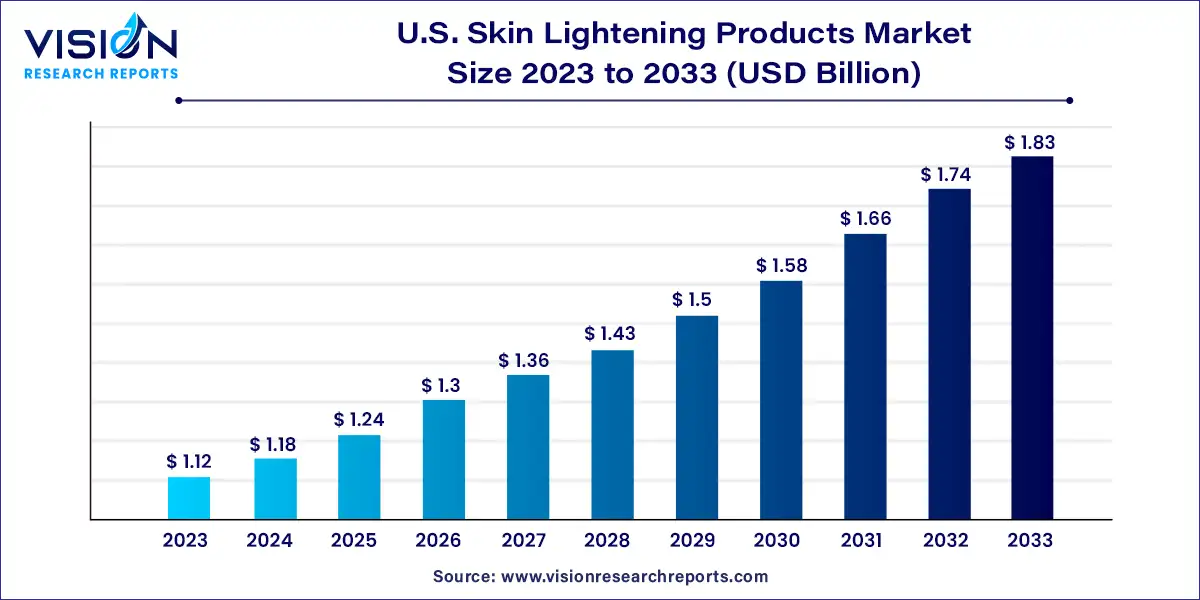The U.S. skin lightening products market size was estimated at around USD 1.12 billion in 2023 and it is projected to hit around USD 1.83 billion by 2033, growing at a CAGR of 5.03% from 2024 to 2033.

The U.S. skin lightening products market has witnessed significant growth driven by evolving consumer preferences and technological advancements in skincare. This market encompasses a wide range of products designed to address skin tone irregularities, hyperpigmentation, and enhance overall skin radiance.
The growth of the U.S. skin lightening products market is propelled by an increasing consumer awareness and demand for skincare solutions addressing skin tone irregularities and hyperpigmentation drive market expansion. Technological advancements in skincare formulations, incorporating ingredients like hydroquinone and kojic acid known for their skin-brightening properties, contribute to product efficacy and safety. Diverse product offerings, including creams, serums, and masks tailored to various skin types, cater to personalized skincare needs, enhancing market appeal. Effective marketing strategies, leveraging endorsements and social media influencers, further boost product visibility and consumer adoption. Regulatory frameworks ensuring product safety and efficacy play a crucial role in shaping market dynamics, fostering consumer trust and market growth.
In 2023, the synthetic category dominated the skin lightening market with over 89% revenue share. Dermatology and cosmetics extensively use chemical ingredients for skin depigmentation, driving their adoption in traditional products. Key chemicals like retinoids, hydroquinone, glycolic acid, and azelaic acid accelerate skin lightening processes due to their potent effects. However, prolonged use of these chemicals may pose risks to skin health. Despite this, ongoing research and development of new chemical compounds for skin lightening products are expected to sustain segment growth globally.
The market for natural skin lightening products is forecasted to grow at a CAGR of 5.83% from 2024 to 2033, driven by increasing demand for chemical-free alternatives. Consumer preferences are shifting from synthetic to natural products due to their perceived benefits and minimal adverse effects. For instance, in July 2020, Vestige launched Assure Natural, a range of vegan, cruelty-free personal care products including sunscreen, day cream, lightening cream, face scrub, sleeping mask, charcoal peel-off mask, and body mask. Rising demand for paraben-free and other chemical-free products is expected to positively impact market growth.
In 2023, skin lightening creams held a dominant market share of 54%. Their easy penetration and effective skin benefits contribute to widespread consumer adoption. Market players are innovating with advanced technologies to enhance cream efficacy. For example, in April 2022, Neutrogena India introduced its New Bright Boost range to combat skin dullness, featuring products like Illuminating Serum, Resurfacing Micro Polish, and Gel Cream. These formulations promise up to 10 times surface skin renewal, achieving brighter, smoother, and more even skin tones.
The skin lightening cleanser market is projected to grow at a CAGR of 5.63% from 2024 to 2033, driven by its multifunctional benefits including discoloration correction, pigmentation reduction, and blemish elimination. For instance, in December 2019, Astaberry Biosciences launched a whitening face wash enriched with natural ingredients like mulberry and liquorice extracts. This product moisturizes, deeply cleanses, reduces tanning, and enhances skin complexion and texture.
By Product
By Nature
 Cross-segment Market Size and Analysis for
Mentioned Segments
Cross-segment Market Size and Analysis for
Mentioned Segments
 Additional Company Profiles (Upto 5 With No Cost)
Additional Company Profiles (Upto 5 With No Cost)
 Additional Countries (Apart From Mentioned Countries)
Additional Countries (Apart From Mentioned Countries)
 Country/Region-specific Report
Country/Region-specific Report
 Go To Market Strategy
Go To Market Strategy
 Region Specific Market Dynamics
Region Specific Market Dynamics Region Level Market Share
Region Level Market Share Import Export Analysis
Import Export Analysis Production Analysis
Production Analysis Others
Others